- Author: Gerry L Hernandez
This is a 7 part series on saving water in your garden and landscape. Here is part 1.
1. Create drought resistant soils
- By incorporating 2-4 inches of compost into the soil you will increase the water holding capacity of the soil
- Topdressing compost around plants will reduce water needs but not up to the plant base. Space @ the base.
- Mulch all exposed soil to reduce evaporation with bark, leaf litter or rocks
Benefit:
- Reduced water usage
These simple steps can save a lot of water, beautify your landscape and improve plant health!
Watch for our next installment on Monday March 16, 2015.
- Author: Gerry L Hernandez
- Check your irrigation system and do necessary maintenance.
- Fertilize roses, annuals flowers, and berries with slow-release fertilizer when spring growth begins.
- Fertilize citrus and deciduous fruit trees.
- Watch for aphids on new growth on the roses; spray with a strong spray of water to remove them, or use insecticidal soap or horticultural oil spray.
- Prepare garden beds by incorporating compost before planting spring vegetables. You can plant lettuce, carrots, and cilantro directly in the vegetable bed. Mid-March is a good time to plant potatoes.
- You can plant canna, gladiolus, and crocosmia for summer blooms. Early in the month you can still plant bare-root trees and shrubs if the garden center still has any.
- Don't be tempted by the plants in the garden centers unless you have a way to warm up the soil. It is still early for tomatoes, eggplant and peppers (although you could try late in the month if it is still warm.) Nights should be above 55°.
- Prune and fertilize spring-flowering shrubs and trees after they finish blooming.
- Fertilize the lawn with a slow release fertilizer.
- Keep on the weed patrol; pull them while they are small.
- Use iron phosphate bait for slugs and snails or go on a night hunt and kill them up when you find them.
- Author: Gerry L Hernandez
Tree watering
What is the best way to water a mature tree? How do I water the tree? How deep do I water my tree?
Roots naturally want to stay in the top 2-3 feet of the soil. It's in their nature to be “shallow”. Why don't the roots grow to infinity and beyond? More nutrients are available to the tree in the top 2-3 feet of soil. Also anaerobic conditions exist in deeper soil and the roots cannot survive there.
So how do we water the tree so that the roots are deep enough for optimal growth and not stick out of the ground?
The University of California has developed a system to easily irrigate trees, it's called Tree Ring Irrigation Contraption (TRIC). Basically you circle the tree at 1 foot intervals with a drip line.
Here is a link to the TRIC information http://ccuh.ucdavis.edu/public/drought/tree-ring-irrigation-contraption-tric-1/tree-ring-irrigation-contraption-tric
Tree photo from Symphony of the Soil.
- Author: Gerry L Hernandez
This article is mainly from the UC Master Gardeners of Butte County's blog, The Real Dirt. I've shortened it.
Ladybugs (Ladybeetles) are beneficial insects that play a major role in keeping down populations of insects that feed on plants. Perhaps most importantly, ladybugs are predators with an insatiable appetite for aphids. A ladybug can eat up to 5,000 aphids over its lifetime. They can also help to rid your garden of other soft-bodied insects such as mites, mealybugs and leafhoppers, along with insect eggs and even ants.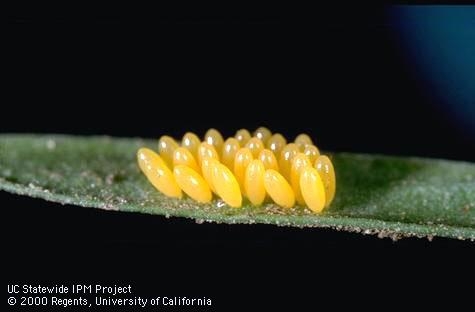
450 ladybug species are native to North America, with 175 of those species found here in California.
Adults mate in early spring (when temperatures reach above 65 degrees) and again in June if the aphid population is abundant. When aphid populations decline, ladybugs migrate to higher elevations.
Ladybugs undergo a complete metamorphosis during their life cycle, moving through the four stages: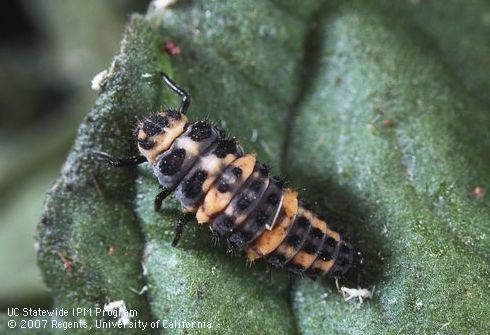
Interestingly, ladybugs beat their wings 85 times per second in order to fly. When threatened, a ladybug can draw its head into its pronotum, like a turtle does, to protect itself.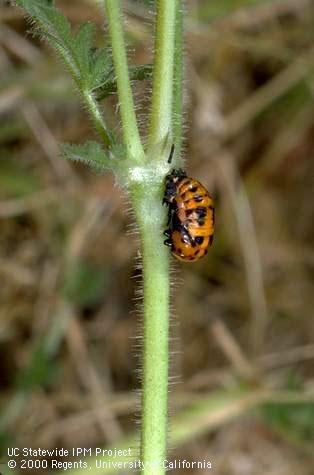
Ladybugs hibernate in the winter months and will not fly when temperatures fall below 55 degrees. They feed on pollen and nectar and live on stored fat through the winter. Ladybugs are not preyed upon by birds or other vertebrates because they exude a very distasteful fluid from joints in their legs; their distinctive colors are a reminder to would be predators they taste “bad”. When threatened, ladybugs will play dead.
How can I attract ladybugs to my garden?
Ladybugs will only hang out in the garden if there is something for them to eat and they eat aphids! If you are going to buy ladybugs make sure you have a ready supply of aphids available. For successful handling and release of ladybugs purchased at a store, keep them refrigerated until time for release. They may be dehydrated when purchased, so mist them with water from a squirt bottle before putting them in the refrigerator. Do not release them into your garden during the daytime or they will fly away immediately. Instead release them at dusk or early morning. Be prepared for ladybugs to fly away in a few days as they typically don't lay eggs on the plants they have been released on. “The key here is to get your neighbors to purchase ladybugs.” Haha, anyway…..
When you see ladybugs, remember that they are considered lucky in many cultures, for various reasons. Enjoy them in your garden until they fly away, fly away home (or to your neighbors' garden).
- Author: Gerry L Hernandez
Perennial Berries and Vines
- Blackberries and Raspberries - Don't let the vines get away from you. Thornless varieties are available. I have a blackberry bush that does not get much water so it stays small. It is like heaven when you eat blackberries from your own vines.
- Blueberries – Full sun, choose southern highbush varieties. Varieties from Maine will not work here. Needs soil to stay moist, so mulch heavily. Use acidic fertilizer. Great shrub!
- Grapes – Beautiful on an arbor or pergola. We had grapes growing on an arbor when I was a kid.
- Strawberries – A lot of types to choose from. They can be grown as an annual or perennial. They have many diseases and pests.
Fruit Trees
If you are going to plant a tree, why not a fruit tree? Fruit trees are easy to keep small if that is what you want. If you have excess fruit, share with a neighbor. I know I would prefer to get figs instead of zucchini!
- Apples – Many varieties to choose from. Codling moth (the worm in the apple) can be a problem.
- Apricots – Many varieties to choose from.
- Avocados – These can be a hit or miss in our area. Your neighbor can have a very fruitful tree and you get nothing. If you are going to plant an avocado, you will need an A and a B plant.
- Cherries – Need lots of chill hours. They need a pollinizer. Birds love cherries, so you may not get many.
- Citrus – grows well in the valley. Oranges are so cheery in the middle of winter.

- Figs – bears 2 crops a year. These trees can be huge but they are easy to keep small. I have 2 fig trees in my yard.
- Kiwis – great on an arbor, pergola or trellis. Be careful what variety you purchase. Some are self-fruitful and some are not.
- Olives – loves our hot dry summers. They are a beautiful landscape tree.They do have a problem with olive fruit fly.
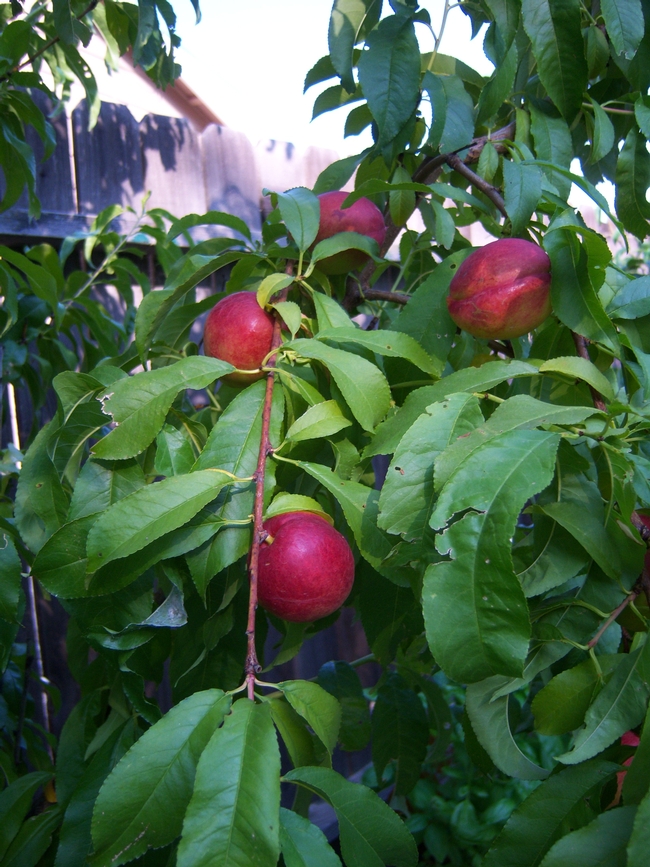
- Peaches and Nectarines – one of the easiest trees to grow here. Lots of varieties! Need to spray for peach leaf curl. I have 2 nectarine trees. One ripens in July and the other in August.
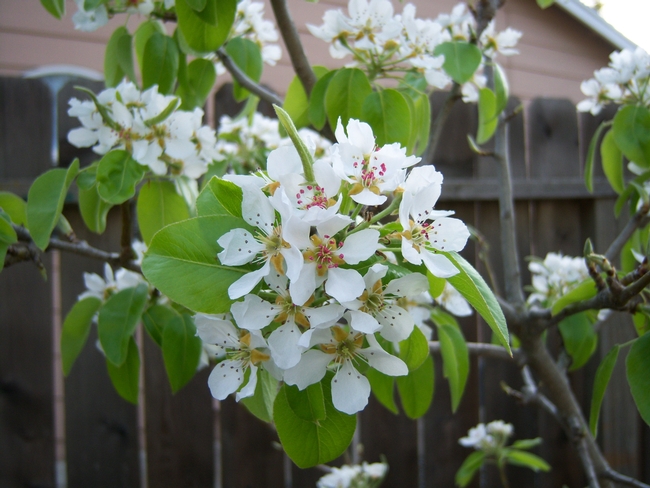
- Pears and Asian Pears– need winter chill. They need a pollinizer trees. Pears have a problem with fireblight.
- Persimmons – Make sure you get the kind of persimmon you want (eating or baking). Beautiful fall foliage.
- Plums – Lots of varieties, sizes and colors.

- Plum Hybrids – Many to choose from and many different flavors. My favorite is the green pluot that comes from a prune variety.
- Pomegranate – Can be a shrub or tree. Beautiful flowers and leaves.








